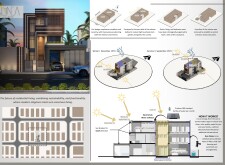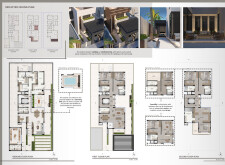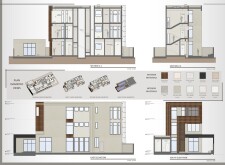5 key facts about this project
### Overview
The Residence Villa is situated in a warm climate that informs its design and functional approach. The project aims to integrate contemporary aesthetic principles with eco-conscious design strategies, addressing the residential demands of its specific geographical context. With a focus on sustainability, functionality, and minimalistic elegance, the design creates a harmonious living environment that maximizes natural light and ventilation.
### Spatial Arrangement
The residential layout is executed over three levels, with a deliberate division between public and private areas. The ground floor comprises interconnected common spaces, including the living room, kitchen, and dining area, fostering social interaction. A traditional sitting area, or majlis, provides a culturally relevant space for communal gatherings. The first floor is dedicated to private spaces such as bedrooms and a library, promoting a retreat-like atmosphere. The flexibility of the second floor allows rooms to be adapted as independent living spaces or terraces, accommodating varying needs over time.
### Material Selection
Sustainability is prioritized through a careful selection of materials that enhance both aesthetics and durability. Wood plastic composite is utilized for cladding, ensuring longevity with minimal maintenance. Porcelain and ceramic floor tiles contribute a modern ambiance while maintaining coherence throughout the interiors. White concrete pavers used in outdoor areas present a clean appearance, while the application of exterior sigma paint plaster enhances durability against environmental elements. This thoughtful approach to materiality supports the overall design intent and environmental objectives.
### Sustainable Design Features
The design incorporates several environmental sustainability features, including solar panels on the roof that reduce reliance on the electrical grid. An innovative water collection system enables the reuse of rainwater for purposes such as irrigation. Additionally, the layout promotes cross-ventilation, facilitating passive cooling and decreasing dependence on mechanical systems. These strategies illustrate a commitment to energy efficiency and ecological responsibility, aligning with the overarching design goals.





















































